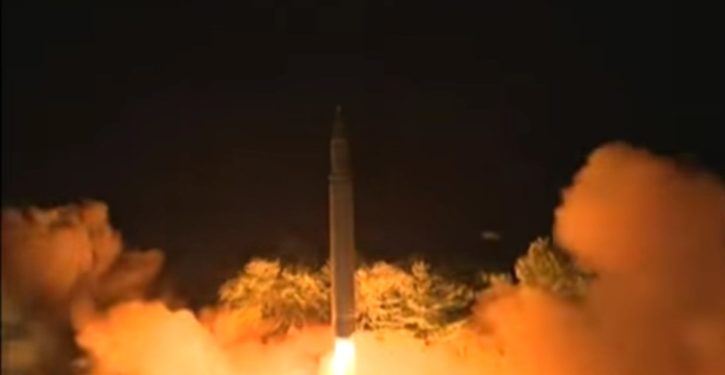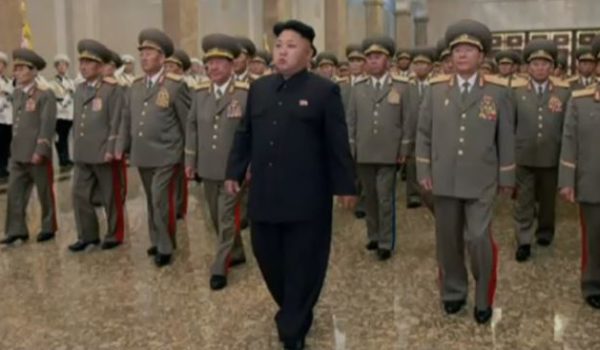
On Monday, the International Institute for Strategic Studies (IISS), a UK-based think tank, published an article by U.S. missile expert Michael Elleman outlining his assessment that North Korea’s newest missiles have probably been made successful by incorporating the former-Soviet-designed RD-250 liquid-fueled rocket engine.
The RD-250 was used in the USSR’s R-36 ICBM program, of which the only remaining operational variant is the SS-18 (“Satan”) R-36M2 (the 10-MIRV mod, or Mod-5). The operational SS-18s have a range of about 11,000 km (6,800 miles).
The RD-250 was developed in the 1960s, when Ukraine was part of the Soviet Union. Its designer was the Russian firm Glushko, and it was manufactured by KB Yuzhnoye’s affiliate Yuzhmash in Dniepropetrovsk (now called Dnipro), Ukraine. The RD-250 was recently used for space-launch rockets through the late 2000s. The Yuzhnoye enterprise is still in business, but the RD-250 is out of production. Yuzhmash produces different, more modern engines for Ukraine’s space-launch rocket industry.
Will this presidential election be the most important in American history?
Elleman’s assessment, which was previewed in early June, is that North Korea is using a modified version of the R-250, which operates on a single combustion chamber instead of the normal two chambers. He doesn’t think the North Koreans have the capability to have produced the engine – even as a copy – or to have made the single-chamber modification themselves. (I would concur with that. There is no evidence of North Korea having such a program or any facility where the work could have been done.)
Elleman identifies the Russian firm Energomash (headquartered in Khimki, in the Moscow suburbs), and Ukraine’s Yuzhmash/Yuzhnoye, as the companies that could have modified the RD-250 for North Korea. His analysis seems to suggest both may have been involved.
With only a single combustion chamber, the modified RD-250 would give a North Korean ICBM a shorter range than the SS-18. Elleman’s analysis indicates that, with a two-stage launch vehicle, it would be sufficient to achieve the 7,000-9,000 km (4,300-5,600 miles) extrapolated from the launches of the Hwasong-14 ICBM prototype on 4 and 28 July.
On the upper end, that would put the United States west of the Mississippi, and a swath of Canada running from Saskatchewan westward, in range from North Korea.
The RD-250 also appears to have been incorporated in the Hwasong-12 intermediate range ballistic missile. In both cases, Elleman’s point is that receiving this “rocket boost,” if you will – foreign-manufactured missile technology that Pyongyang could not develop itself at this point – has given the Kim regime’s missile program a hard jolt forward.
His best estimate suggests the engines were made available in the period from late 2015 to 2016. (He seems to favor the end of 2016, although he’s not perfectly explicit about that. If the launch tests are not being actively supervised by Russians, however, I would expect the North Koreans to need more lead time to achieve the success they did in July 2017.)
Clearly there would be enough engines to have conducted the tests so far, although we can’t be certain that there are enough to build an arsenal with. Elleman observes that there would be an inventory of RD-250s in Russia and Ukraine, given their relatively recent retirement (ca. 2009) from military and space-launch use. North Korea may well have more of them on-hand.
The North Koreans are presumably also back-engineering them as we speak. They haven’t been the world’s quickest studies in that regard, but it is wise to assume that the engine technology is now “proliferated.”
Profound implications
Yuzhmash in Ukraine has already come out with a statement that it had nothing to do with sending rocket engines to North Korea – which would violate both the UN sanctions on North Korea and the Missile Technology Control Regime (MTCR), an international non-proliferation pact to which Ukraine has been a signatory since 1998. (Russia is also a member of MTCR.)
Of course, Elleman speculates that the engines could have been moved by criminal networks rather than state agents. It’s conceivable for the steps to have occurred without the foreknowledge of company executives or responsible government officials in either Ukraine or Russia. That said, the criminal networks remain viable by keeping state agents on their “payrolls.”
I haven’t seen a statement from a Russian source yet. But if Elleman’s assessment is correct, it is probable that actors in both nations are implicated. Using the RD-250 in an ICBM – the specific project in North Korea – is an enterprise that involved experts in both countries.
Moreover, it would be necessary to deliver the engines to North Korea. The lowest-vulnerability path for that would have its last leg from the Russian Far East to North Korea. Cargo deliveries to North Korea from elsewhere are watched too closely by South Korea, Japan, and China to make the longer, more vulnerable transit paths by sea a good option for such high-value items.
If the ultimate deliveries occurred from the Far East, the options include cargo flights from Vladivostok in Russia to North Korea; rail cargo from Khasan, Russia to Rajin, North Korea (a route that was opened in 2013); and shipping from Vladivostok to ports in North Korea. I would favor the likelihood of rail delivery, an option that has the signal advantage of avoiding the big cargo hubs in Vladivostok, where spy networks are better able to operate.

Credible scenario
Bases on recent history, none of these possibilities – the involvement of actors in Ukraine and Russia, and deliveries through Russia – can be discounted. There are reasons to consider them valid and credible.
For example, in 2012, Ukraine caught North Korean agents trying to buy technology for liquid-fueled rockets from Yuzhnoye. It would be a mere matter of persistence for Pyongyang to keep after that objective, in spite of the setback. (The Chinese sales mentioned in the NTI report involved other missile-system components, not the rockets themselves.)
It’s worth noting as well that Yuzhnoye and Russian firms continue to do business, even after the de facto partitioning of Ukraine. The very long association of these state enterprises has not been suspended by the political tensions since 2014. Their importance to both nations transcends other considerations.
One other intriguing factor has been something of a mystery in Ukraine this year. Yuzhnoye is working on a short-range ballistic missile system, Grom-2, which is billed as comparable to the Russian Iskander system (deployed for several years to Eastern Europe). The oddity is that the project is being funded by an unnamed foreign buyer, who has put in $40 million so far.
Such arrangements may be simply straightforward. Somebody wants Grom-2s. But they may also be used to justify paying $40 million to Yuzhnoye, for something else unrelated to the Grom-2.
That situation could have nothing to do with North Korea’s missile program. But RD-250 engines seem to have gotten to North Korea somehow. If we don’t already know how, this is one thing to check.
In 2015, meanwhile, Russia was stepping in with North Korea to make up for a calculated reduction in Beijing’s trade with Pyongyang. Some analysts viewed this as a way for Russia to retaliate against the U.S. sanctions imposed because of Ukraine. (Another factor is the Sakhalin pipeline that Russia wants to run to South Korea. There have been talks for years about putting part of it through North Korea; that option may or may not pan out, but keeping the option alive gives Moscow a bargaining chip in more than one negotiating process.)
More recently, Russia boosted trade with North Korea an astounding 85% over the previous year in the first four months of 2017. Given that Pyongyang had been incessantly violating sanctions and pursuing its nuclear and missile programs prior to that, including two warhead tests in January and September 2016, this can only be interpreted as a Russian intention to embrace North Korea nukes and all.
Russia is playing a bigger game than merely shouldering out China, of course, or retaliating against the United States. In building influence with North Korea, Putin has in mind the whole situation of the Far East.
But regarding the specific concern of rocket engines for North Korea’s missile program, this overall trend in Russian policy creates favorable conditions for cargo deliveries to North Korea, and even technical cooperation, whether officially sanctioned by the government in Moscow or not.
I wouldn’t write off the possibility that cooperation with North Korea on ICBM technology does have official sanction in the Kremlin. Russia’s pattern in this regard is one of making herself a primary broker of key technology, which puts her in the position to be involved in her clients’ decisions, and tighten or loosen the spigot.
This has been evident over the years in Russia’s relations with China, Iran, and other clients of high-value technology. To suggest that Moscow is letting rocket engines go to North Korea is not to say that the Russians are cavalierly shipping off dangerous missile parts heedless of the potential consequences for Russia. Rather, it is to acknowledge that Russia views stringing clients along as a way of retaining leverage and influence.
On this topic, it is interesting to note that in July 2017, after the first Hwasong-14 test launch, Russia made the seemingly inexplicable assessment that the missile’s range capability was much shorter than that assessed by U.S., South Korean, and Japanese experts. The discrepancy prompted a startled reaction from these other experts:
“This is so baffling that Russia would have such a different assessment of the Hwasong-14 launch,” Mark Fitzpatrick, a scholar at the International Institute for Strategic Studies, told VOA’s Korean Service. “It’s almost as though Russia saw a totally different launch or made up the numbers.”
Analysts speculated that the Russians had technical limitations that prevented them from detecting all aspects of the launch, and that Moscow wanted to play down what happened to discourage a renewal of U.S. enthusiasm for missile defenses.
These explanations would have the Russians coming off as oddly over-emphatic (i.e., if they didn’t have enough technical data to dispute others’ findings with such certainty), or even kind of obtuse. A case can be made, however, that consciousness of guilt would explain Russia’s jarringly emphatic stance pretty well.
Russian sanctions evasion
A final piece of the puzzle is Russia’s recent track record on North Korean sanctions. It’s a murky area, but Russia can be justly regarded as a key point of failure – for every mode of transport. Starting with probably the least likely mode of transport, scheduled fights between Vladivostok and Pyongyang occur twice a week. (There are also regular runs between Pyongyang and Beijing, Shenyang, and Shanghai. Beyond these, North Korea has little air traffic with the outside world.)
There isn’t much systematic public insight into what’s going on via the air route. At sea, meanwhile, in March of 2016, Russia allowed a sanctioned North Korean cargo ship to enter Vladivostok only a week after fresh UN sanctions were imposed in the wake of the January 2016 nuclear warhead test. Subsequent tracking suggested the ship proceeded to the vicinity of Chongjin, North Korea, although it had indicated its next destination was Dalian, China.
We don’t know what cargo may have been involved in this excursion, of course. (It’s at least noteworthy that it falls in the timeframe of the potential RD-250 deliveries.) But the data point is there as a precedent. Shortly afterward, South Korea successfully pressured Russia to not allow another sanctioned ship to enter Vladivostok.
U.S. lawmakers take the possibility of sanctions evasion through Russian ports seriously, introducing a House bill in May 2017 to require the Trump administration to perform special monitoring. The sheer proximity and aggregate information about Russian relations with North Korea make it likely that there has been more suspect activity at sea by now than the public is aware of.
The rail connection may be the most problematic of all. In 2016, when the new UN sanctions were adopted, Russia voted for them only because she was able to dilute them – by specifically excluding her rail project with North Korea, and Pyongyang’s exports of coal and minerals through Russia, from the sanctions. The rail connection to Khasan, Russia is a principal route for North Korean coal exports, and allowing it meant that trains would run regularly back and forth across the border. But, as mentioned above, the rail route through Khasan bypasses Vladivostok, where the capacity for foreign monitoring is inherently greater.
In general, the more economic activity there is between Russia and North Korea, the more opportunity there is to move things around in cargo holds and containers. We can assume that most if not all enterprises are undertaken for their primary, overt purposes – but rail cars heading back to North Korea from Khasan could always be carrying something.
(One other intriguing transport possibility is outlined in this post, from 2014, on the voyage of a cargo ship from Russia’s Baltic port of Ust-Luga to Rajin, North Korea, via the “Northern Sea Route” across Russia’s Arctic frontier. This route would suffer from limited, seasonal availability and the potential for a high failure rate – but it would be the very devil to interdict.)
Overall, the implications of this development are extremely troubling, and hard to dismiss. Whether we live in a world in which criminal networks can actually proliferate proven ICBM technology to rogue states, or one in which signatories to the MTCR pact have done so, it’s not the world of stable expectations most people have imagined. And we’ve been living in it for some time now.




